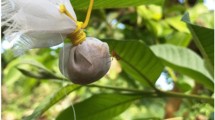Abstract
Studies were carried out at Mbita Point Field Station, South Nyanza, western Kenya from 1984 to 1987 to determine the role of Dentichasmias busseolae Heinrich in the population dynamics of Chilo partellus Swinhoe and its potential as a biological control agent against the stem borer. D. busseolae is a solitary endoparasitoid which parasitizes and completes its development in the pupa of C. partellus. The developmental period ranged from 64.5 ± 9.5 days at 15°C to 12.0 ± 1.5 days at 30°C for males, and from 66.7 ± 9.8 days to 13.1 ± 2.1 days for females, respectively.
The intrinsic rate of natural increase of the parasitoid was 0.1375, and the population multiplied 24.21 times in the mean generation time of 28 days. The functional response was curvilinear.
Field parasitism in maize and sorghum was evident 7 weeks after plant emergence (APE). Thereafter, parasitism was persistent until crop harvest. The range of parasitism was 0 to 45.5% (× = 23.3%) on maize and 9.7 to 90% (x̄ = 36.0%) on sorghum respectively. Using laboratory and field observations, a model for the host searching process of D. busseolae has been constructed. The potential of the parasitoid in biological control programmes of C. partellus is also discussed.
Résumé
Les études ont été menées à la Station de Mbita située au Sud de Nyanza, dans l’Ouest du Kenya, de 1984 à 1987 afin de déterminer le rôle des Dentichasmias busseolae Heinrich dans la dynamique de la population de Chilo partellus Swinhoe et son potential en tant qu’agent de contrôle biologique contre les insectes résistants. D. busseolae est un endoparasitoide qui vit en parasite et arrive à terme de son développement sous la forme d’une nymphe de C. partellus.
Le développement s’étend sur une période allant respectivement de 64,5 ± 9,5 jours à 15°C, à 12,0 ± 1,5 à 30°C pour les mâles et de 66,7 ± 9,8 jours à 13,1 ± 2,1 jours pour les femelles.
Le taux intrinseque de l’augmentation naturelle du parasitoïd est de 0,1375 et la population est multipliée par 24,21 au cours d’une période moyenne de 28 jours.
Le parasitisme dans le maïs et le sorgho s’est manifesté 7 semaines après la germination (APE). Ensuite, le parasitisme a persisté jusqu’à la récolte. Le taux de parasitisme va respectivement de 0 à 45,5% (x̄ = 23,3%) pour le maïs et 9,7 à 90% (x̄ = 36,0%) pour le sorgho.
En nous servant du laboratoire et des observations effectuées sur le terrain, un modèle de recherche de D. busseolae a été mis sur pied. Le potentiel des programmes de contrôle biologique de parasitoïde C. partellus a fait également l’objet des discussions.
Similar content being viewed by others
References
Bahana J. W. (1989) Bioecological studies on Dentichasmias busseolae Heinrich (Hymenoptera: Ichneumonidae), the parasitoid of Chilo partellus Swinhoe (Lepidoptera: Pyralidae) and its potential for biological control. Ph.D. thesis.
Bains S. S. and Shukla K. K. (1976) Effect of temperature on the development and survival of maize borer, Chilo partellus (Swinhoe). Indian J. Ecol. 3, 149–155.
Birch L. C. (1948) The intrinsic rate of natural increase in an animal population. J. Anim. Ecol. 17, 15–26.
Force D. C. (1972) r and strategist in endemic host parasitoid communities. Bull. Entomol. Soc. Am. 18, 135–137.
Holling C. S. (1959) The components of prédation by a study of small mammal prédation of the European pine saw fly. Can. Entomol. 91, 293–320.
Howe R. W. (1953) The rapid determination of intrinsic rate of an insect population. Ann. Appl. Biol. 40, 134–155.
Mohyuddin A. I. (1972) Distribution, biology and ecology of Dentichasmias busseolae Heinrich (Hymenoptera, Ichneumonidae) a parasite of graminaceous stem borers (Lepidoptera, Pyralidae). Bull, entomol. Res. 62, 161–168.
Mohyuddin A. I. and Greathead D. J. (1970) An annotated list of parasites of graminaceous stem borers in East Africa, with a discussion of their potential in biological control. Enlomophaga 15, 241–274.
Nikam P. K. and Basarkar C. D. (1981) Life tables and intrinsic rate of natural increase of Xanthopimpla stemmator Thurenberg (Hymenoptera: Ichneumonidae) population on Chilo partellus pupae. Insect Sci. Applic. 2, 209–212.
Oloo G. W. (1984) Parasitoid studies on cereal stem borers in monocrop and intercrop systems. ICIPEAnnu. Rep. 1984 pp. 16–17.
Southwood T. R. E. (1978) Ecological Methods with Particular Reference to the Study of Insect Populations. Chapman and Hall, London.
Author information
Authors and Affiliations
Rights and permissions
About this article
Cite this article
Bahana, J.W. Bioecological Studies on Dentichasmias busseolae Heinrich and its Potential for Biological Control of Chilo partellus Swinhoe. Int J Trop Insect Sci 11, 765–772 (1990). https://doi.org/10.1017/S1742758400021329
Received:
Revised:
Published:
Issue Date:
DOI: https://doi.org/10.1017/S1742758400021329




